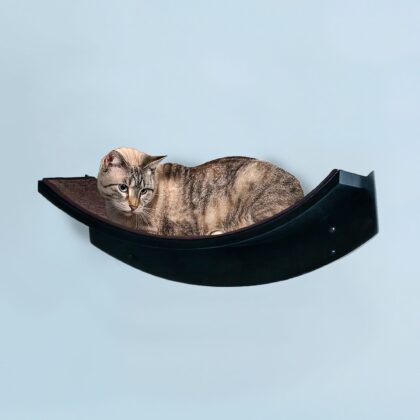
How To Pet A Cat
For the new or unbeknownst cat owner, it may seem appropriate to immediately try to cuddle with your new cat. The cat may have other ideas though! Most cats are not going to let you pet them right off the bat, especially if they haven’t met you before. They need time to warm up to you, and some cats may not ever want to be touched. Before you try to pet a cat, continue reading The Refined Feline’s list of do’s and don’ts when it comes to feline affection.
Tips On How To Pet A Cat
First, it’s important to know that not all cats want to be petted (you can read more about this later on). Plus, even cats that want to be petted will have areas that they don’t want to be touched, just like humans. Cats tend to have a lot of boundaries, so if you continually pick a spot they don’t enjoy being petted, they will walk away.
Introduce Yourself First
Let cats approach you and sniff your hand before you try to pet them, as they will want to know your scent first. You must allow them to approach and sniff you first to get comfortable with your presence. If they are standing around you and making eye contact, then you can attempt to pet them. You’ll want to pet them as gently and smoothly as possible as short pets or more jerky movements can scare them. However, if they smell you and walk away, or start to move their body away from your hand, stop attempting to pet them. A cat that does not want to be touched can react unpredictably.
Be Mindful Of Where You Pet
A cat will typically prefer scratches down their sides and back, and sometimes a few at the base of the tail. Cats do like their head and chin scratched, but you may need to build some trust before petting those areas. Being able to read and respond to your cat’s body language during these petting sessions is key. You’ll see when your cat leans into certain areas when being scratched, and when they shy away from being touched in other areas.
Make sure to avoid touching a cat’s legs or belly at first, unless you know that specific cat enjoys it. Cats will roll over and expose their belly to someone they trust, but that doesn’t always mean they want the area touched. They may bite or swat at you if you attempt to pet this area, so be sure not to unless you’re pretty sure they’ll enjoy it. You don’t want to try to touch or pet a cat who is in a corner or feels trapped. This can make them more fearful of your approach and touch, even if they do generally enjoy pets.
Let The Cat Guide You
Some cats can be scratched under the chin or at the base of their tail for hours while other cats can get riled up after a few pets in one area. When cats are becoming overstimulated, they will typically twitch their tail or even swat at your hand. Start to pet slowly and for short amounts of time, stopping before the cat becomes tired of the affection. It’s important to pay attention to your cat’s reaction when being petted.
Note: Not All Cats Want To Be Pet
Most humans want to shower animals with affection, and who can blame them? It’s hard to resist wanting to show affection to an adorable animal whether it is outside or in our home. However, some cats may not want to be petted at first and some cats may never want to be petted at all.
Kittens Are More Open To Being Pet
When cats are young, they are more open to becoming socialized with humans, including their scents, speech, and touch. If they don’t receive this socialization while they are young, they may not want or seek attention. This can be challenging if you had your heart set on a super affectionate cat! If a cat’s mother is apprehensive or scared of people, this can also give her kittens a negative impression of humans. This can lead to them being more skittish around humans and being petted.
Let Your Cat Choose You
Be sure to meet and greet a cat before adopting. Some cats will gravitate toward certain people just as some people prefer certain people over others. Find out as much about your cat’s history as you can, although there might not be much information if they are a rescue, However, knowing their past can help you discover whether they have interacted much with humans and if they like to be petted.
Pay Attention To Body Language
You’ll notice if cats are shy if they stare at you with open eyes (like a deer in headlights) or if they try to leave the room entirely. So, if you’re looking for an affectionate cat right away, it might be better to adopt a more outgoing cat. Don’t assume that an affectionate cat always enjoys pets though or wants company all the time. Cats can be independent and ultimately choose when they want to be around you. It’s best to let a cat approach you first whether it’s for affection or anything else.
Most Cats Can Be Socialized
If a cat isn’t a huge fan of physical affection at the moment, this does not mean that it won’t want attention down the road. Some cats may never want much interaction with humans but many will open up over time in the right environment. If a cat has had a bad experience with a human, that can make them shy away from attention as they think that behavior is the norm. Some cats are immediately open to affection while other can take months or years to open up.
Create Positive Experiences
When cats have more positive interactions with humans, they sometimes realize it isn’t so bad! If a cat requires some warming up, start slowly and on your cat’s terms. A cat may not want any attention if they are in the middle of something, even if that’s a cat nap. When approaching shy cats, they may lower their body to the ground more, widen their eyes, and slowly back away. A cat may also not want attention if they are uncomfortable, not feeling well, or are simply hungry. No matter the location or circumstance, if cats are not in the mood for attention, being respectful of their space will improve the relationship.
Related: 5 Ways To Strengthen Your Relationship With Your Cat
Give Affection On Your Cat’s Terms
Letting a cat come to you for attention helps build trust and gives the cat more autonomy. If cats enjoy being petted, they will respond with their body language. They will lean into the pets and rub their face against your hand and body, marking you with scent glands located on their face. Cats may even start to purr, headbutt, and/or knead you with their claws. They may place their rear end closer to your hand for scratches and pets along their back and at the base of their tail.
Pay attention to your cat’s overall body language at the moment, as this is going to be the most accurate way to know what your cat wants. Cats can have “off” days just like humans. Paying attention to your cat’s body language at the moment will clue you in on how much attention they want. So, it’s best to not force any kind of attention onto your cat. Forced attention can lead to cats wanting less attention, and even becoming fearful or aggressive.
Learn How To Pet A Cat With These Tips
Hopefully, you have learned a thing or two about what to do and not do when petting cats. They can be fickle felines, but once you gain their trust, they are friends for life!










